- Bernard Preston homepage
- Nutritious choice foods
- Natural Treatments for Porphyria
Natural treatments for porphyria
Natural treatments for porphyria require a return to the "very good foods" that our great-grandmothers once served; and avoidance of that which is ultraprocessed.
This is a long and complex page; it's not a two-minute skim read. It is only for those who are serious about the possibility of managing porphyria with natural treatments.
Quick guide
What are porphyrins?
Porphyrins are normal, natural chemicals in the body that must go through eight steps to form a very important compound called heme; each requires a specific enzyme that is synthesized according to our genes.
Some people but not all those suffering from porphyria inherit a gene that limits the production of one of those enzymes.
Porphyrins then build up in the blood and in fact thus throughout the body; skin, liver and kidneys are often affected. Urine may turn red or brown.
But the interesting part is that simply because you may have inherited the faulty gene, doesn't mean you will suffer from porphyria; in fact most people do not.
So there are many conditions where genetic testing confirms we have inherited a faulty chromosome but do not get the disease. It's only when some other factor in your lifestyle causes a build up of dangerous free radicals that further damage the DNA and are unable to produce those important enzymes that the levels of porphyrins in the blood start to rise.
So anti-oxidant foods are an essential part of the natural treatments for porphyria but in truth for all of us.
The skin in porphyria
Missing enzymes in the liver mean that porphyrins are not converted properly into heme; a build up of the chemical occurs and sometimes is transported to the skin which becomes very sensitive to light.
Since light falling on the skin is the chief source of vitamin D, those suffering from the disease often become deficient; they have to rely on their food for the nutrient.
Worldwide vitamin D is said to be the most prevalent and maliferous pandemic; those with porphyria have to work very hard at obtaining these foods and only very short exposures to sunlight.
The Nervous System and porphyria
The build up of porphyrins typically targets the nervous system; thus muscle weakness and tingling are common; and because of poor peristalsis, constipation.
They have to eat more fibre than most people, probably over 40 grams per day particularly that which is in the soluble form; oats, chickpeas and fruit especially.
Heme
Heme is the iron-carrying part of haemoglobin that enables our blood to transport oxygen to all parts of the body. Because there is insufficient owing to one or more of those damaged enzymes, many people suffering from porphyria may be anaemic; they may need transfusions.
The body is then unable to handle this important mineral so iron supplements must be rigorously avoided despite the anaemia. So too must "plant-based meat alternatives" to which synthetic heme has often been added to give it a beefy taste.
This raised iron from synthetic heme produces the "reactive oxygen species" that attack our genes increasing the likelihood of chromosome damage and hence makes us more prone to porphyria.
These ROSs also damage the beta-cells in the pancreas making us prone to diabetes[2].
Anti-oxidant foods
And so the anti-oxidant foods are those containing especially the vitamins A, C and E; in fact we should all be consuming them daily to prevent ROS damage of our chromosomes.
In truth vitamins A and C are plentiful in the wholesome diet; only E remains more difficult because of the ultra-refining of wheat flour. Extraction of the germ and bran to give bread improved "mouth feel" makes the important tocopherols elusive.
Vitamin E also acts as a powerful anticoagulant preventing the formation of clots, making the true wholegrain loaf an essential part of the natural treatments for porphyria. That is why heart attacks were extremely rare prior to the refining of flour.
Vitamin A
So vitamin A and its precursor beta-carotene is the first of our antioxidant nutrients. From animal sources it's highest in dairy products, eggs and fish.
Many of the yellow, orange and green foods are rich sources of beta-carotene, also known as preformed vitamin A.
None of us in short should be deficient in vitamin A but alas that is not the case; it is for example the chief cause of blindness in children worldwide; nearly three million every year. This makes them also susceptible to ROS damage and porphyria.
Yellow cornmeal is another rich source of beta-carotene.
 True wholemeal yellow grits; the cream enhances the absorption of the beta-carotene.
True wholemeal yellow grits; the cream enhances the absorption of the beta-carotene."Do not eat any refined-carbs, period."
Dr Atkins
Greens also have vitamin K
However those suffering from porphyria may be treated with anticoagulants to prevent stroke and phlebitis; which would be countered by the vitamin K in greens. So kale, broccoli and spinach are usually then disallowed. Herein lies a dilemma; a deficiency of lutein and consequent blindness is possible.
Macular degeneration
Apart from the beta-carotene avoidance of greens would make them deficient in lutein
too and thus more likely to have the added burden of macular degeneration. We recommend taking supplements of this very important carotene if nutritious foods like kale, broccoli and spinach are disallowed.
Vitamin C
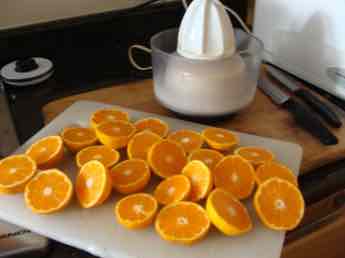
Vitamin C too is a powerful antioxidant that protects our genes from damage by reactive oxygen species. It is richly found in citrus and peppers; we should all consume some of each daily.
Citrus is the source of another carotene called beta-cryptoxanthin; it's the only nutrient proven to help prevent dementia. Everyone in fact should be eating an orange, lemon or grapefruit daily. South Africans love their "naartjes;" the Hindi word for mandarins.
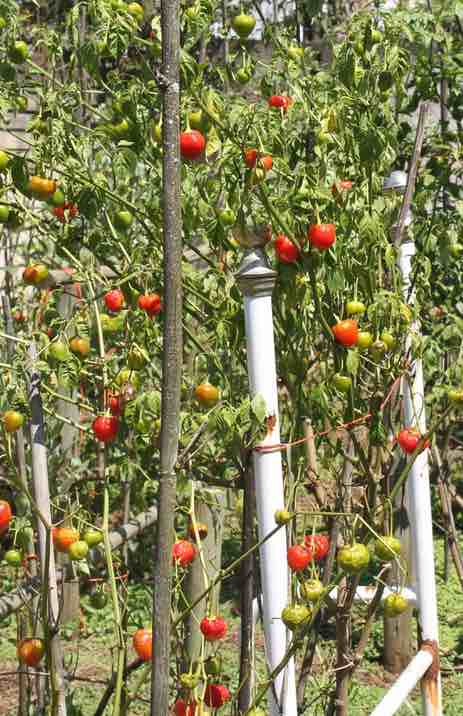
Peppadews are so easy to grow; they are prolific. They are also a rich source of not only vitamin C but also capsaicin that has many other benefits; like the prevention of prostate cancer.
Not only those suffering from porphyria but all of us should be enjoying these rich, nutritious and tasty foods.
Vitamin E
Vitamin E is the spoke in the wheel especially as it is a family of eight different compounds; only those enjoying a broad diet of many coloured foods are likely to be getting sufficient.
The alpha-tocopherol form is found in the germ and bran of wheat; the modern day loaf contains almost none. The only real solution is to mill your own flour and bake bread; a bridge too far for most but absolutely essential as one of the natural treatments for porphyria.
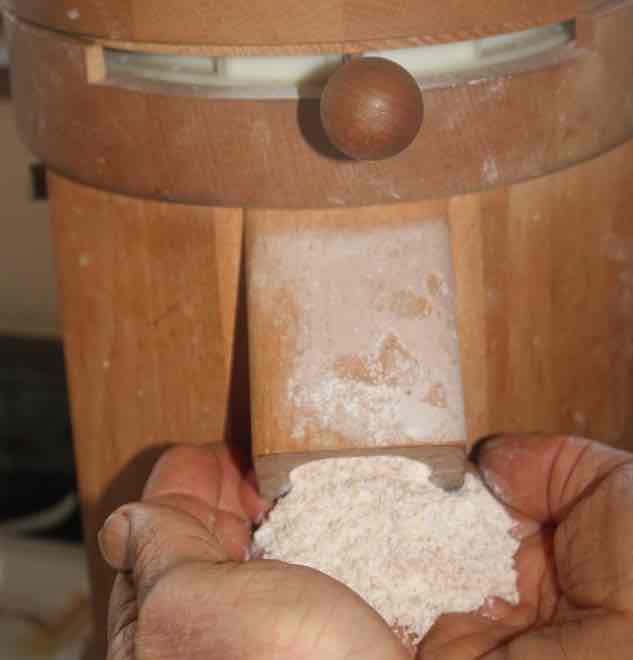 Utterly unavailable commercially
Utterly unavailable commerciallyZinc to reduce porphyrins
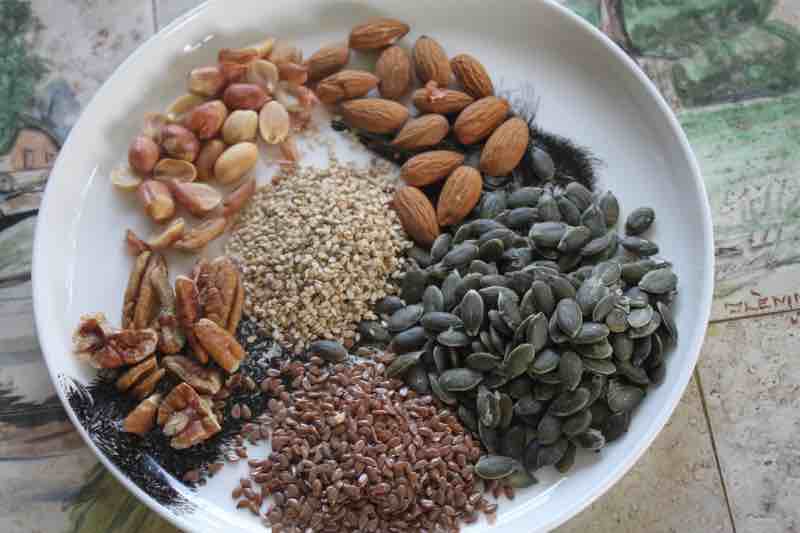
Zinc is a mineral that has powerful antioxidant properties. Nuts, seeds and green leafy vegetables are all rich sources.
Almonds, peanuts and pumpkin seeds are encouraging sources of zinc, magnesium and many other important nutrients.
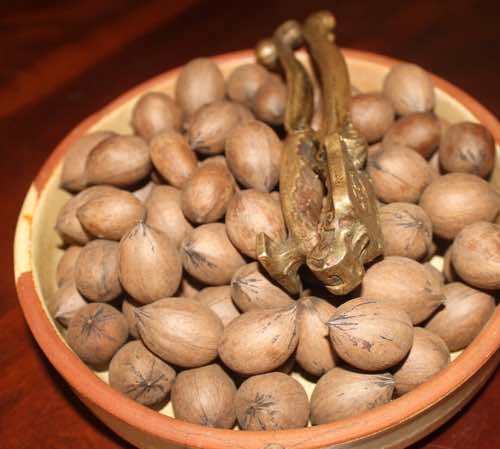
The pecan bowl should never leave the dining room table. The smaller nuts like these Elliots are less prone to fungal infiltration but are harder to crack.
Foods rich in vitamin B6
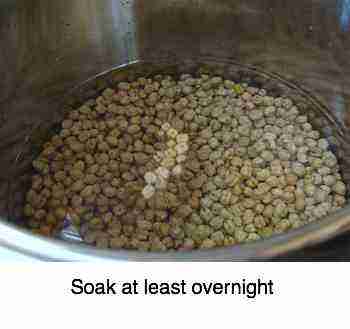
Vitamin B6 is particularly involved in anaemia; serum levels are very often low in the public at large but especially in those with porphyria. Chickpeas are the best source, also low in iron and rich in vegetable protein; and soluble fiber.
Foods rich in vitamin D
Fatty fish like salmon, eggs and mushrooms are particularly good sources of vitamin D. They are very important for those with porphyria; in fact for all of us since a deficiency is so common.
"Human judges can show mercy. But against the laws of nature, there is no appeal."
- Sir Arthur C. Clarke
Nutritional advice for persons with porphyria
Health is additive in both a positive and negative sense. The official site of the porphyria foundation stresses that the combination of the poor diet enjoyed by most shopping at typical grocery stores plus porphyria is likely to be a disaster.
It means becoming something of a health nut, doing whatever one can to prevent or at least retard the relentless onward march of porphyria.
They stress avoiding the obesity associated with ultra-refined carbs but not all starches; very low blood glucose up-regulates the ALAS1 enzyme leading to a greater likelihood of acute porphyria attacks.
Obesity is not helpful but nor would any one of the many keto diets be.
SUMMARY
- No greens; lutein supplements instead.
- True whole grains especially oats and wheat to keep glucose up but avoiding obesity; not easy to locate.
- Plenty of orange and yellow foods; carrots, butternut and gooseberries for example.
- Nuts and seeds daily.
- Chickpeas.
- Foods rich in vitamin D.
Natural treatments for porphyria
Natural treatments for porphyria stresses an emphasis on antioxidant meals.
Grasping all of the above helps us to understand why that which the Porphyria Foundation[3] states actually is applicable to all of us who want to live long and healthy lives.
"There is no special or particular diet required or recommended for persons with Porphyria. Rather, the principles of good and sensible nutrition apply."
- The Porphyria Foundation
When browsing use right click and "Open Link in New Tab" or you may get a bad gateway signal.
Newsletter
Our newsletter is entitled "create a cyan zone" at your home, preserving both yourself and Mother Earth for future generations; and the family too, of course. We promise not to spam you with daily emails promoting various products. You may get an occasional nudge to buy one of my books.
Here are the back issues.
- Lifestyle and ideal body weight
- What are ultra-processed foods?
- Investing in long-term health
- Diseases from plastic exposure
- Intensive lifestyle management for obesity has limited value
- A world largely devoid of Parkinson's Disease
- The impact of friendly bacteria in the tum on the prevention of cancer
- There's a hole in the bucket
- Everyone is talking about weight loss drugs
- Pull the sweet tooth
- If you suffer from heartburn plant a susu
- Refined maize meal and stunting
- Should agriculture and industry get priority for water and electricity?
- Nature is calling
- Mill your own flour
- Bake your own sourdough bread
- Microplastics from our water
- Alternative types of water storage
- Wear your clothes out
- Comfort foods
- Create a bee-friendly environment
- Go to bed slightly hungry
- Keep bees
- Blue zone folk are religious
- Reduce plastic waste
- Family is important
- What can go in compost?
- Grow broad beans for longevity
- Harvest and store sunshine
- Blue zone exercise
- Harvest and store your rainwater
- Create a cyan zone at your home
Did you find this page interesting? How about forwarding it to a friendly book or food junkie? Better still, a social media tick would help.
- Bernard Preston homepage
- Nutritious choice foods
- Natural Treatments for Porphyria
Address:
56 Groenekloof Rd,
Hilton, KZN
South Africa
Website:
https://www.bernard-preston.com